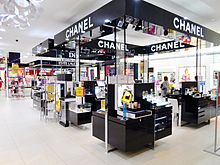Ingredients

A variety of organic compounds and inorganic compounds comprise typical cosmetics. Typical organic compounds are modified natural oils and fats as well as a variety of petrochemically derived agents. Inorganic compounds are processed minerals such as iron oxides, talc, and zinc oxide. The oxides of zinc and iron are classified as pigments, i.e. colorants that have no solubility in solvents.
Naturaledit
Handmade and certified organic products are becoming more mainstream, due to the fact that certain chemicals in some skincare products may be harmful if absorbed through the skin. Products claimed to be organic should, in the U.S., be certified "USDA Organic".
Mineraledit
The term "mineral makeup" applies to a category of face makeup, including foundation, eye shadow, blush, and bronzer, made with loose, dry mineral powders. These powders are often mixed with oil-water emulsions. Lipsticks, liquid foundations, and other liquid cosmetics, as well as compressed makeups such as eye shadow and blush in compacts, are often called mineral makeup if they have the same primary ingredients as dry mineral makeups. However, liquid makeups must contain preservatives and compressed makeups must contain binders, which dry mineral makeups do not. Mineral makeup usually does not contain synthetic fragrances, preservatives, parabens, mineral oil, and chemical dyes. For this reason, dermatologists may consider mineral makeup to be gentler to the skin than makeup that contains those ingredients. Some minerals are nacreous or pearlescent, giving the skin a shining or sparking appearance. One example is bismuth oxychloride. There are various mineral-based makeup brands, including: Bare Minerals, Tarte, Bobbi Brown, and Stila.
Porous mineralsedit
Porous minerals is a subcategory of mineral makeup ingredients where the porosity of the mineral particles enables extraordinary absorption capacity compared to non-porous mineral materials. This feature improves sebum control, long-lasting mattifying effect or gives a matte texture when used in makeup. Porous minerals can also act as carriers, absorbing a wide range of substances into its porous network.
Benefits of mineral-based makeupedit
Although some ingredients in cosmetics may cause concerns, some are widely seen as beneficial. Titanium dioxide, found in sunscreens, and zinc oxide have anti-inflammatory properties. Many mineral based makeup create a barrier between the skin and outside elements, which allows it to provide some protection against the sun and its possible harmful effects.
Mineral makeup is noncomedogenic (as long as it does not contain talc) and offers a mild amount of sun protection (because of the titanium dioxide and zinc oxide).citation needed
Because they do not contain liquid ingredients, mineral makeups have long shelf-lives.
Comments
Post a Comment